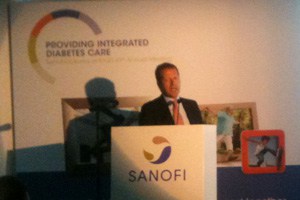 Senior figures in Sanofi’s diabetes division have confirmed that the decision to withdraw the US application for marketing approval of Lyxumia was the most beneficial option to the company.
Senior figures in Sanofi’s diabetes division have confirmed that the decision to withdraw the US application for marketing approval of Lyxumia was the most beneficial option to the company.
Speaking to PMLiVE at the 2013 meeting of the European Association for the Study of Diabetes (EASD) in Barcelona, chief medical officer for the global diabetes division Riccardo Perfetti (pictured) backed the decision made earlier this month following an FDA request for interim analysis of a study into the drug’s cardiovascular safety.
It means that Sanofi will not file for approval of the drug until the study is completed in 2015, putting any approval at least two years behind Europe, where Lyxumia was launched earlier this year.
“The FDA filing for glucose lowering medicines require cardiovascular study,” explained Perfetti, acknowledging the precedent set by the US regulator in 2008. “You cannot file if your data cannot show that the risk is within a certain boundary. So if the FDA accepted a file, it must be within that boundary. But what wasn’t clear was the management of the interim analysis of study results.”
Professor Matthew Riddle, a professor in the medicine at Oregon Health and Science University and a member of the steering committee for the ELIXA trial to assess the cardiovascular profile of Lyxumia, further explained the rationale behind Sanofi’s decision, saying that providing the FDA with early analysis of data could “jeopardise the proper conduct of the trial”.
He said: “This has happened in other studies where preliminary results have been reported in a way that has confused, alarmed or distracted people from the study being done. So to protect the quality of the trial we thought it was in the best interest of the study that the FDA not have preliminary data.”
Sanofi is not the only company to have a marketing application for a diabetes drug hindered by strict US regulation, with Novo Nordisk facing a three year delay for its next generation insulin Tresiba to obtain the appropriate cardiovascular data despite approval in Europe.
“Europe approaches glucose lowering medication in context of overall risk-benefit of a treatment,” said Perfetti, explaining how the regulatory environment differs between the US and Europe.
“Nobody has disputed that glucose lowering produces microvascular complications. But in the US in the last 10 years we seem to have only focused on one side of the coin when each coin has two.”
Despite this setback, Sanofi was positive of the progress of Lyxumia in the rest of the world, explaining that it will soon debut in Japan and Brazil following launches in Europe and elsewhere.
The company also presented data that back the drug’s use as a complementary treatment to a basal insulin, such as its own blockbuster Lantus (insulin glargine).
Of particular note in the GetGoal-L study was the affirmation of Lyxumia’s effectiveness in lowering glucose levels in patients after a meal, supporting combination treatment with a background basal insulin.
In addition, this effect, as well as weight loss and overall reduction in blood sugar levels, was found to be greater in patients who had well-controlled fasting plasma glucose.




